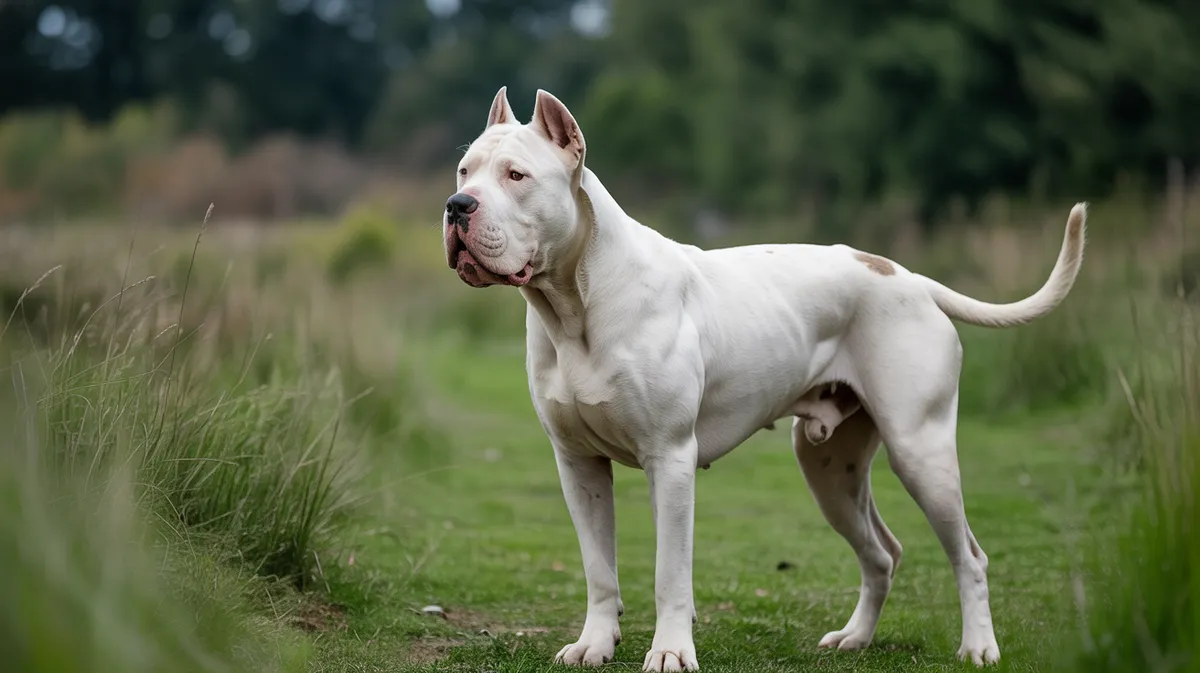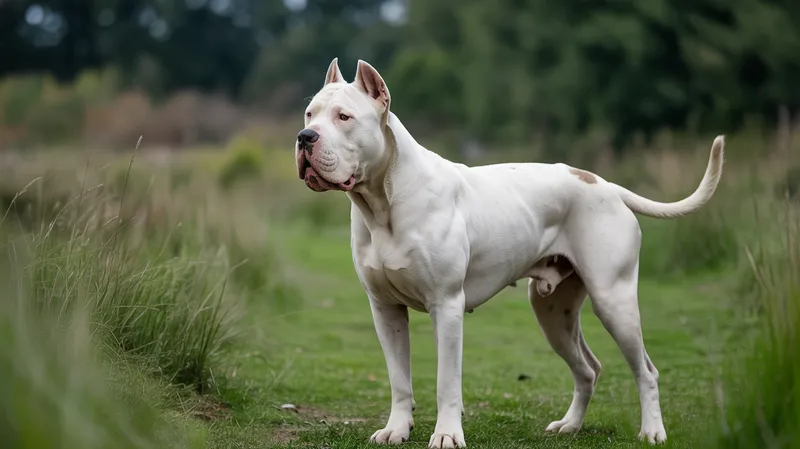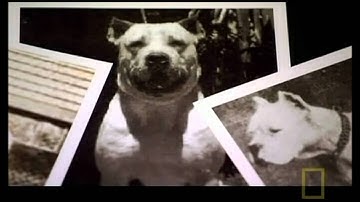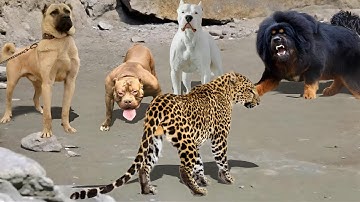
Dogo Argentino
Canis lupus familiaris

Meet the Dogo Argentino
The Dogo Argentino is a large, muscular dog breed developed in Argentina primarily for big-game hunting, such as wild boar and puma. Renowned for its striking white coat, powerful build, and athleticism, the breed is also known for its courage, intelligence, and loyalty. Dogo Argentinos are highly trainable and protective, making them excellent working dogs and devoted family companions when properly socialized. Because of their strength and prey drive, they require experienced handling and early socialization.
Classification
Mammal
Habitat
Grassland and forested areas in rural and semi-rural environments
Diet
Carnivore
Lifespan
9-15 years
Conservation
Not Evaluated
Weight
35-45 kg (77-99 lbs)
📖Fascinating Facts
Purpose-Bred Hunter
The Dogo Argentino was specifically bred to hunt large and dangerous game, combining traits from breeds like the Cordoba Fighting Dog, Great Dane, and Boxer.
Striking Appearance
They are almost entirely white, with very few markings allowed, to make them more visible during hunts and prevent accidental injury from hunters.
Protective and Loyal
Known for their unwavering loyalty, Dogo Argentinos are natural guardians and are protective of their home and family.
📋Detailed Description
The Dogo Argentino is a robust, athletic, and powerfully built dog, typically standing 60–68 cm (24–27 in) at the withers and weighing between 40–48.5 kg (90–105 lb) for males, with females slightly lighter and shorter. Its most distinctive feature is its short, smooth, completely white coat, which provides camouflage in the field and helps reduce heat absorption in the Argentine sun. The breed has a broad, slightly domed skull with a strong, square muzzle and well-developed jaws, reflecting its ancestry as a big-game hunter. The ears are typically set high and may be cropped in some countries, though natural ears are increasingly preferred. The Dogo Argentino possesses a deep chest, muscular neck, and a balanced, athletic frame that allows for both explosive speed and endurance. Behaviorally, the breed is known for its courage, tenacity, and high pain tolerance, traits selected for during its development for hunting dangerous prey such as wild boar and puma. Dogos are intelligent, highly trainable, and form strong bonds with their human families, often displaying protective instincts and a gentle demeanor with children when properly socialized. They are generally calm and stable in temperament, but their strong prey drive and territorial instincts require experienced handling and consistent training. Social structure within groups is typically hierarchical, with clear dominance relationships, and they may show same-sex aggression if not well socialized. Reproduction is typical of large breeds, with moderate litter sizes and attentive maternal care.
💡 Did you know?
Despite their tough appearance, Dogo Argentinos can be very gentle and affectionate with their families, often seeking close contact and companionship.
🔬Research & Sources
Wikipedia Summary
The Dogo Argentino is an Argentine breed of large dog of mastiff type. It was bred in the early twentieth century in Córdoba in central Argentina, primarily for hunting large game such as peccaries, wild boar, and pumas. The foundation stock included the now extinct Córdoba fighting dog, a fighting dog of bulldog type, a Bull Terrier and a Mastín del Pirineo.
Last Modified: 6/4/2025
🎭Behavior & Social Structure
Dogo Argentinos are highly energetic and require significant daily exercise, including running, tracking, and interactive play, to maintain their mental and physical health. Their hunting heritage manifests in a strong prey drive and a tendency to track scents or pursue moving objects. In hunting settings, Dogos work both individually and in coordinated packs, using their keen sense of smell and stamina to locate and hold large game until hunters arrive. Socially, they are loyal and affectionate with their families, often forming close attachments and displaying protective behaviors. They may be wary or aloof with strangers, making early and ongoing socialization critical. Dogo Argentinos are known for their intelligence and problem-solving abilities, which, combined with their strength, necessitate firm but positive training methods. They are generally quiet dogs, barking only when necessary, and are observant of their environment. Daily routines should include structured activities, obedience training, and opportunities for social interaction to prevent boredom and the development of undesirable behaviors.
👶Reproduction & Life Cycle
The Dogo Argentino reaches sexual maturity around 18–24 months of age. The breed typically comes into estrus twice a year, with the female's heat cycle lasting approximately 2–3 weeks. Mating is usually natural, though responsible breeders carefully select pairs to maintain health and temperament standards. Gestation lasts about 63 days, after which the female gives birth to litters averaging 6–8 puppies, though larger litters are not uncommon. Neonatal care is intensive, with mothers providing warmth, nutrition, and protection. Puppies are born blind and deaf, opening their eyes after about 10–14 days. Breeders emphasize early socialization, exposing puppies to various stimuli and gentle handling to foster stable temperaments. Weaning occurs at 4–6 weeks, with gradual introduction to solid foods. Parental care is primarily maternal, though in multi-dog households, other adults may assist in socializing the young.
🛡️Adaptations & Survival
The Dogo Argentino exhibits several adaptations for its role as a big-game hunter. Its muscular build and deep chest provide strength and endurance for long pursuits and physical confrontations with large prey. The breed's white coat, a deliberate selection by its creators, aids in visibility for hunters and reduces the risk of accidental shooting during hunts. The skin is thick and somewhat loose, especially around the neck, offering protection against bites from prey animals. High pain tolerance and a strong, stable temperament are behavioral adaptations that enable the Dogo to persist in challenging situations. The breed's acute olfactory senses and strong jaw muscles are evolutionary specializations inherited from its diverse foundation stock, including fighting and working breeds. Additionally, the Dogo's intelligence and trainability are crucial for responding to complex commands and adapting to varied working environments.
📚Research Sources
🎨Cultural Significance
The Dogo Argentino holds a prominent place in Argentine culture as a symbol of national pride and rural heritage. Developed in the 1920s by Dr. Antonio Nores Martínez and his brother Agustín, the breed was intended to embody strength, courage, and loyalty—qualities valued in the Argentine countryside. It is celebrated as the national dog of Argentina and is featured in literature, art, and folklore. Traditionally, the Dogo has been used for hunting large game and as a guardian of property and livestock. Its image is associated with bravery and resilience, and it is often regarded as a loyal family protector. The breed's development is a testament to selective breeding and the blending of various European and local dog types to create a uniquely Argentine working dog.
🔬Recent Research & Discoveries
Recent scientific studies have focused on the genetic diversity of the Dogo Argentino, particularly in relation to hereditary deafness, which affects approximately 10–12% of individuals due to the absence of pigment cells in the inner ear. Ongoing research aims to identify genetic markers for health screening and to improve breeding outcomes. Behavioral research has examined the breed's suitability for various working roles, including search and rescue, therapy, and law enforcement, highlighting its intelligence and adaptability. Studies on breed-specific legislation have evaluated the impact of legal restrictions on population trends and welfare. Conservation efforts by breed clubs emphasize maintaining the Dogo's original working traits and genetic health through responsible breeding and international collaboration.
🎥Wildlife Videos

Dogo Argentino A Fearless Encounter With A Fearless Predator
a fearless Dogo Argentino comes face-to-face with a powerful mountain lion in the wild.
Wild Wonders

The Science behind the Dogo Argentino
donnieyang123

WORKING LINE DOGO ARGENTINO - Banned & Dangerous?
Today we meet the HUNTING, WORKING LINE Dogo Argentino and compare him to the showline Dogo Argentino I met in Italy.
Animal Watch

THE DOGO ARGENTINO DOG - DANGEROUS & BANNED?
The Dogo Argentino is a brave hunting and guardian breed, but his back history in dog fighting genetics has him banned from ...
Animal Watch

LEOPARD VS KANGAL, PITBULL, DOGO ARGENTINO AND TIBETAN MASTIF (REAL VIDEO)
LEOPARD VS KANGAL, PITBULL, DOGO ARGENTINO AND TIBETAN MASTIF (REAL VIDEO) Indian leopards have already ...
Nature’s Secrets

Dogo Argentino vs German Shepherd #DogoArgentino #GermanShepherd #WildlifeDocumentary #DogLovers
Dogo Argentino vs German Shepherd #DogoArgentino #GermanShepherd #DogShowdown #WildlifeDocumentary #DogLovers ...
Animals World.official
🌍Habitat Information
The Dogo Argentino typically inhabits Grassland and forested areas in rural and semi-rural environments environments. Dogo Argentinos have adapted to their environments with specialized features and behaviors.
Primary Habitat:
Grassland and forested areas in rural and semi-rural environments
More detailed habitat information will be available soon.
🛡️Conservation Status
The Dogo Argentino is currently classified as Not Evaluated. Conservation efforts are crucial for preserving this species for future generations.
Common Threats:
- 🏠Habitat loss and fragmentation
- 🌡️Climate change impacts
- 🎯Hunting and poaching
- 🏭Human-wildlife conflict
⚠️Threats & Conservation Challenges
While the Dogo Argentino is not currently considered at risk, the breed faces several challenges. In some countries, it is subject to breed-specific legislation (BSL) due to its strength and perceived aggression, leading to restrictions or bans that can impact population numbers and genetic diversity. Poor breeding practices, including inbreeding and selection for aggression rather than stable temperament, pose risks to health and behavior. The breed is also susceptible to certain hereditary conditions, such as deafness (particularly in all-white breeds), hip dysplasia, and skin issues. Human impact, including irresponsible ownership, lack of proper socialization, and abandonment, can lead to behavioral problems and negative public perception. Conservation of the breed's working abilities and genetic health is a focus among reputable breeders and breed clubs.
🔬Scientific Classification
Scientific Name
Canis lupus familiaris
Classification Hierarchy
🔍 About Taxonomic Classification
Taxonomic classification is a hierarchical system used by scientists to classify and organize living organisms based on shared characteristics and evolutionary relationships.
The system moves from broad categories (Kingdom) to increasingly specific ones, with each animal's scientific name typically consisting of its Genus and species.
📝Community Notes
Share your observations and insights about the Dogo Argentino with our community of wildlife enthusiasts.
Join Our Community
Sign in to share your observations and connect with fellow wildlife enthusiasts.
Sign In to ContributeNo community notes yet
Be the first to share your observations about the Dogo Argentino!
Explore Dogo Argentino
Select a tab above to learn more about this amazing animal.
📸Photo Gallery
No photos available for this animal yet.
🌟Discover More Wildlife
Continue your journey of discovery with more fascinating animals from our database
